By H. Maurer, June 2017. All photos in this essay can be used for any purpose, yet it would be polite to add a link showing where they original come from.
About 70 km SE of Turku and 50 km N of the most southern tip of Finland, Hanko , along route 1824 going south from Salo, iron ore was found in the 17 th century, starting mining activities in mainly three places, Mathildedal (or Matilda for short), Teijo and Kirjakkala
Hanko, Finland, Salo,Finland, Mathildedal,Finland, Teijo, ...
.

Typical house near the beach-road in the seadside resort Hanko. Photo: U. & H. Maurer, June 2017

Church of Teijo. Photo: U. & H. Maurer, June 2017
The ironworks there played an important role in the history of industrializing Finland. Mathildedal ironworks have been restored to some extent as a cultural heritage representing the 19th century metal industry, with many old buildings adapted for various purposes. It is Mathildedal this report is mainly concerned with.
The origins of Mathildedal ironworks go back to 1686. Mr Lorenz Creutz from Teijo was granted a right to build a forgery in Hummeldal. In 1825 Mr Robert Bremer discovered ironstone in the ground starting a period of growth for Hummeldal factory and the whole area. His son Viktor Zebor Bremer continued running the ironworks after him. In 1852 he founded a new factory in Hummeldal and renamed the village to Mathildedal after his wife Mathilda. (The ocean bay the village is located on is still called Hummelfjord.)

Iron processing. Photo of old picture: U. & H. Maurer, June 2017

Iron processing before 1900. Photo of old picture: U. & H. Maurer, June 2017
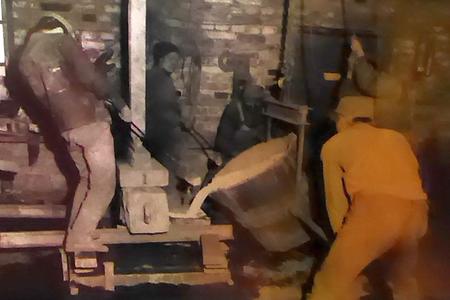
Iron processing before 1900. Photo of old picture: U. & H. Maurer, June 2017

Scrap iron from ships, like the ice-breaker Sampo mentioned below. Photo of old picture: U. & H. Maurer, June 2017

The start of an iron processing museum in one of the old buildings. Photo: U. & H. Maurer, June 2017
From 1850 till well after 1920 Mathildedal (or Matilda for short) grew into a substantial place. It was almost self-sustaining: The ironworks were much more than just a workplace for its employees. They provided all other necessary services. The employees rarely left the area. Almost everything was produced locally. Every employee had a warm place to sleep, single men often together with others in a larger room, families with proper accommodation. Everyone owned a patch of vegetables, a field for growing potatoes, and a few animals, typically a few chicken or pigs, a cow in a common stable and access to fishing both in the ocean-bay Mathildedal is located on, or in each of the numerous lakes with a good stock of pikes, perch and few trout-like species. Salaries were low, but so were the prices in the local store and bakery, and many things were thrown in for residents: not just housing, but also medical treatment at a simple clinic, schooling for kids in a building that also was used as church, some parts as sauna, as meeting place, etc. Nature was generous by providing a variety of wild berries, mushrooms, hazel-nuts and allowing to grow some fruit trees, typically apples.
Nature around the village is beautiful in every season, and suitable for many activities: from ice-fishing to cross-country skiing, from swimming in invigorating waters, from canoeing to hunting, etc. Today, most of the area is part of the Teijo National Park, with many beautiful trails, like the one around Lake Mathilda (Mathildanjärvi), a 2- 3 hour hike along the shore with some possible detours, through bogs on a boardwalk, and up and past many of the typical finish granite boulders with a cover of lichen and moss.
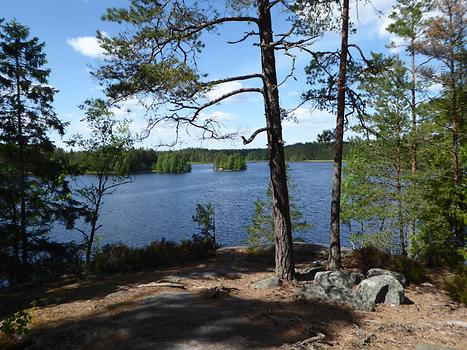
Start of trail around the lake. Photo: U. & H. Maurer, June 2017

Along the trail. Photo: U. & H. Maurer, June 2017

On a boardwalk. Photo: U. & H. Maurer, June 2017

On a boardwalk. Photo: U. & H. Maurer, June 2017
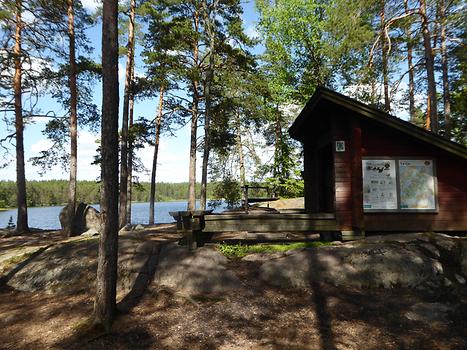
One of the typical huts with a place prepared for grilling some food. Photo: U. & H. Maurer, June 2017

Beautiful birch-wood has been cut and split for hikers and is available for lighting a fire at no cost. Photo: U. & H. Maurer, June 2017

Granite rocks, some surprisingly high. Photo: U. & H. Maurer, June 2017

Some of the "climbing" turns a bit into an exercise. Photo: U. & H. Maurer, June 2017

On top of one of the rocks. Photo: U. & H. Maurer, June 2017

Rock. Photo: U. & H. Maurer, June 2017
Mathildedal housed a few thousand people at some stage. However, in the years between WWI and WWII iron-production became non-profitable. Some was replaced by turning to carpentry and such, yet the closing of the school in 1967 was a signal of the beginning of the end of the village. As it turned into a ghost town, buildings started to fall into disrepair. That Sampo, Finlands most successful steam powered icebreaker (built in 1898!) that played a big role throughout 60 years of Finland’s history was dismantled as scrap iron in 1960 in a small dock in Mathildedal as one of the last such undertakings is rather fitting.
For some 30 years the village was almost non existing. In the nineties it was purchased by a history lover with an eye to make use of its unique settings: some industrial or housing buildings were sold and /or renovated at least a bit and used for various purposes. By now (2017) Mathildedal has surprisingly nice infrastructure and new businesses, yet has managed to preserve the whole environment in a typical 19th century ironworks milieu. Today the remaining buildings serve as a centre for cultural tourism. The services offered are open year-round.
One of the newer of these services is Hotelli Ruukin Majatalo hotel which was built as a loft-like structure in the building that previously housed the machine shop. The hotel has eight rooms, each a bathroom and modern amenities like television and free internet. All this in a building where you would not expect it. The lower part of the building houses a coffee shop that is also selling other items, providing excellent support for high –grade conference and function services offered in another former ironworks building nearby.

When you see some of the houses you sort of ask yourself: Is this really where you have booked a holiday?. Photo: U. & H. Maurer, June 2017

In the shop/ coffe shop in the lower part, where you pick up the keys the atmosphere is surpisingly cosy, even if some of the machinery was left, of course on purpose. Photo: U. & H. Maurer, June 2017

Old machinery in the shop. The entrance to the rooms is at the back of the house, you are told, when you pick up the keys. Photo: U. & H. Maurer, June 2017

Reception of hotel and shop. Photo: Krista from Mathildedalin Ruukkitehtaat
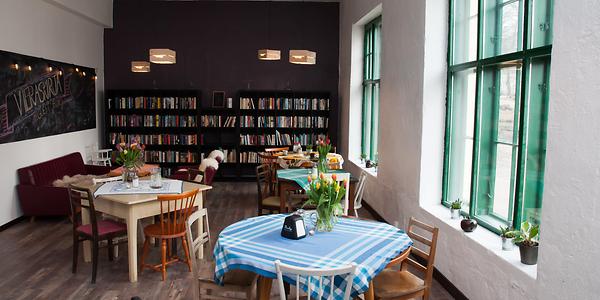
Cosy breakfast area and library. Photo: Krista from Mathildedalin Ruukkitehtaat
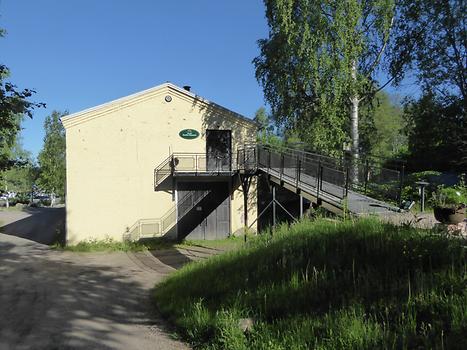
The back of the house looks renovated. Photo: U. & H. Maurer, June 2017

Yet the black iron stairs/ walkway leading to the rooms do not look that inviting. Photo: U. & H. Maurer, June 2017

However, a couple - guests of the hotel- seems to be in very good mood. And as you enter the house you understand. The entrance area offers a nice old table with little snacks, coffee, tea and other stuff for all guests, and your room is modern and stylish, even if the outside has not changed! Photo: U. & H. Maurer, June 2017

Typical room. Simple but in perfect condition. Photo: Krista from Mathildedalin Ruukkitehtaat

From the window you can see a rebuilt old water-wheel that (you learn) was first driving machinery in many buildings through a system of belts, and was later used to produce electricity for the whole village! Photo: U. & H. Maurer, June 2017
Food and meals are served at the colourful Kyläkonttori & Puoti café in the building that previously housed the transformer and at Ruukin Krouvi at the old hardening shop. Or, more recently, in one of the new buildings with a very good restaurant in the substantial marina. Other businesses have started up: An Alpaca farm and shop with one of the few Alpaca mills in Europe (turning wool to threads) allowing to produce elaborate and beautiful Alpaca products, from scarfs to carpets, some handwoven in location by one of the few weavmasters of Finland. The local brewery with excellent beers, like “Mathilda”, a light wheat-beer that has won international awards is in the same building as the local bakery offering the typical dark bread of the area!
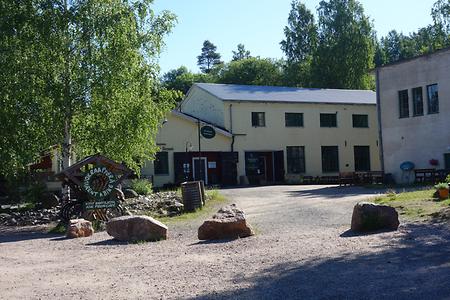
Entrance to area of the marina. Photo: U. & H. Maurer, June 2017

Part of the marina. Photo: U. & H. Maurer, June 2017

Food in Ruukin Krouvi is excellent. You are treated more as family friend than a guest, so it takes you a long time to realize that the ceiling still shows that this now nice room was used for cast iron steel production some 100 years ago. Photo: U. & H. Maurer, June 2017

That the village has its own bakery and beer brewery is one other surprise. Photo: U. & H. Maurer, June 2017

And that alpacas are raised here for their wool in a number of herds is unususal. Photo: U. & H. Maurer, June 2017

Alpacas. Photo: Krista from Mathildedalin Ruukkitehtaat
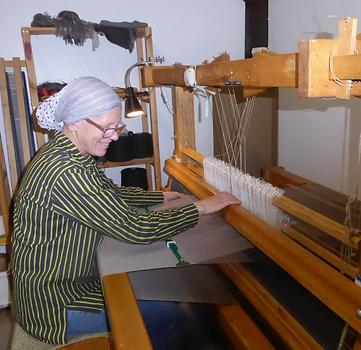
That in the alpaca shop beautiful clothing, scarfs, etc. made locally from the wool is even more surprising when you realize that some of the alpaca carpets are woven in the shop by a weavemaster or her students. Photo: U. & H. Maurer, June 2017

Modest looking entrance hides to alpaca store hides the surprises you will see. Photo: Courtesy alpaca shop

Initial alpaca products. Photo: Courtesy alpaca shop

Elegant alpaca clothing. Photo: Courtesy alpaca shop

Elegant alpaca clothing. Photo: Courtesy alpaca shop
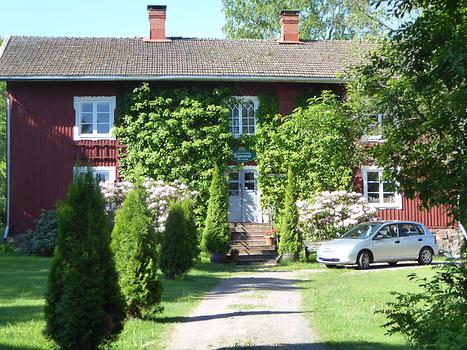
The "Sypressi" is a log house built in 1840, offering B&B, and much more . Photo: U. & H. Maurer, June 2017

The former school building is now a large guesthouse. Photo: U. & H. Maurer, June 2017

The Antipoffi used to house up to 100 employees after it was built in 1852. Photo: U. & H. Maurer, June 2017

The exterior was maintained as it looked in industrial times, but inside there is now modern accommodation for a number of families. Photo: U. & H. Maurer, June 2017

One further of the number of buildings erected to accommodate workers. Photo: U. & H. Maurer, June 2017

Ruukinkartano manor, built 1852, was the home of the factory owner. Photo: U. & H. Maurer, June 2017

View of Ruukinkartano manor through the trees. Photo: U. & H. Maurer, June 2017

Another nice house, built by one of the managers of the factory. It has a private pool by damming the creek that turns the water-wheel further downstream. Photo: U. & H. Maurer, June 2017

Pavillon near the private swimming pool. Photo: U. & H. Maurer, June 2017
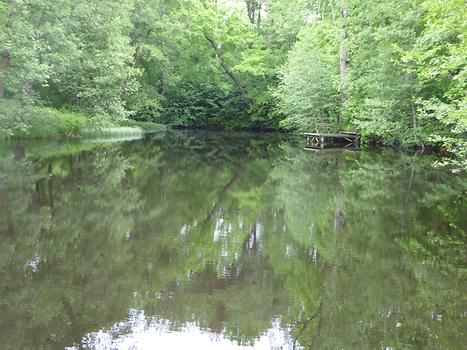
Still further upstream the damming of the creek has produced a larger pool for the public. Photo: U. & H. Maurer, June 2017

One of the other small houses built some 100 year ago. In Matilda the color red means it is the house of an ordinary employee, yellow means it is a house of one of the managers or foremen. Photo: U. & H. Maurer, June 2017

One of the other smaller houses, a house of one of the managers or foremen. Photo: U. & H. Maurer, June 2017
That Teijo-National park is partly located in the area administered by the village is just one other big attraction, with its network of well-kept trails offering surprise after surprise. A nearby golf course, the fact that even a downhill slope with a tow-rope is offered for skiing in winter and that there are numerous B&B places and cottages for rent must not distract from what is really important: That cultural history is woven together with nature by a sizeable community where many decided to change their life from being “important persons” in some city to now living with nature a modest life among many new friends. This feeling does spill over to visitors open for chats, history and nature and fans of handicraft-work, local food production, but also interested in cultural activities like in the out-door theatre, good for plays or concerts.
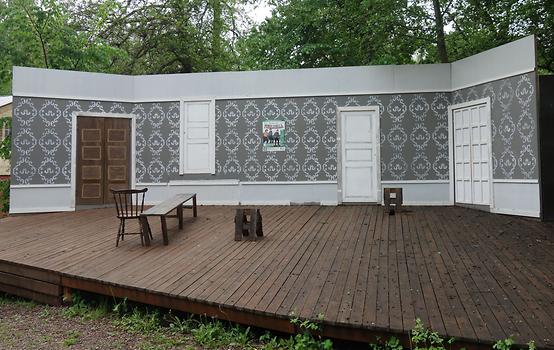
Stage of the outdoor theatre. Photo: U. & H. Maurer, June 2017

Let us hope it is not raining during a performance! Photo: U. & H. Maurer, June 2017

Another attractive place is the property of a former manor in Teijo, complete with rocks, lakes, a swimmign place, and many non-native plants introduced by the former owener. Photo: U. & H. Maurer, June 2017

Lakeview. Photo: U. & H. Maurer, June 2017
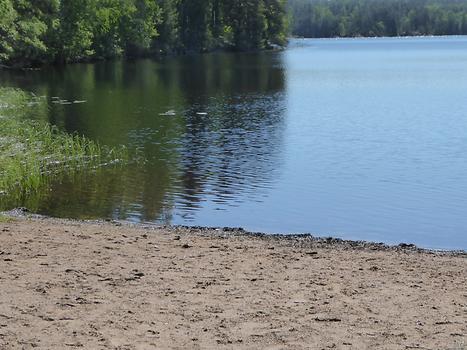
Sandy swimming spot. Photo: U. & H. Maurer, June 2017
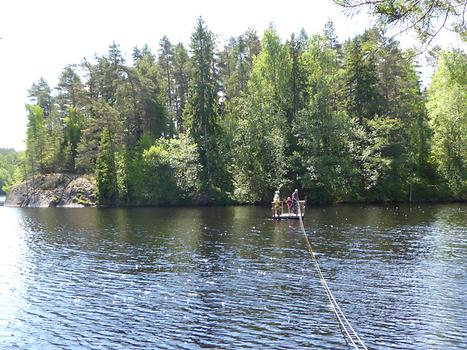
By a clever construction one can cross over to islands or such. Photo: U. & H. Maurer, June 2017

The idea is to pull a float anchored on both sides with a rope running over some pulleys. Photo: U. & H. Maurer, June 2017

This is the rope to pull. Photo: U. & H. Maurer, June 2017

Just a few kilometers from Matilda a short hike leads to Jeturkasti: Here, 80 m above sea-level is a bit of the original coast: The southern part of Finland is still lifting a bit. A large assembly of headsized round boulders in the middle of an otherwise ordinary forest is quite extraordinary! Photo: U. & H. Maurer, June 2017
Many new people from Turku or such have now built some house or cabin near or in Matilda, fortunately most almost invisibly built into the surrounding forested areas. Yet maybe the biggest danger to the charming combination of industrial history, the feeling to belong to a closely-nit group of villagers fond of more regionality rather than globalization, and of real life rather than big success is that the influx of new residents and visitors that is increasing will ruin this unique combination.
Mathildendal is also a good place to explore the archipelago south of it: Many roads lead to the shores of the Baltic sea, with islands making the scene interesting and picturesque. The main place to visit is certainly Hanko, the southernmost city of Finland on a peninsula mainly consisting of sand, much like the Curonian spit of Lithuania.
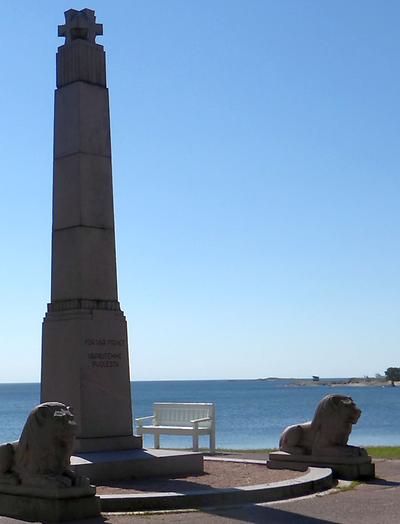
Monument thanking Germany to help the "whites" to succeed and end the civil war, assuring that Finland was a non-communistic country after 1918. Photo: U. & H. Maurer, 2017
Hanko is a city of about 10.000, located on the peninsula Hankoniemi, 127 km from Helsinki and 141 km from Turku.
44 % of the population are Swedish speaking (compared to the country's average of 7%). The city is officially bilingual.
Hanko (Hängö in Finish) has played a major role in the history of Finland after the Finish independence declaration in 1917. The declaration of independence from Russia (it was an arch-duchy of Russia from 1809 till 1917, with Finland being part of Sweden for hundreds of years before the Russians took over) led to a civil war between the "reds" (communists) wanting to take over and re-join Russia and the "whites", who fought for independence.
The problem for the whites was that Finland up to then did not have a separate army, yet the "reds" had weapons given to them when the Russians left. Germany trained thousands of "whites" and provided them with weapons.
Hence Germany is often considered as essential to end the civil war in 1918. This is the story behind a monument thanking the Germans. The monument is located at the beginning of the promenade along the sea-shore.
This beautiful shore with large sandy streches but also impressive granite outcrops and beautiful villas turned Hanko into a posh sea-side resort between WWI and WWII.
The winter-war 1939 to 1940 was fought by the Fins bravely against an overwhelming Russian force. Russia took Hanko in the peace treaty March 13, 1940. One condition was that inhabitants of Hanko had to leave to make room for a detachment of 30.000 Russian soldiers.
In the new war ("continuation war") Finland fought it back in August 1941. In the peace treaty September 19, 1944, Russia did not take Hanko but Porkkala as military base since it was closer to Helsinki.

Villa on the promenade. Photo: U. & H. Maurer, June 2017

Villa on the promenade. Photo: U. & H. Maurer, June 2017

Villa on the promenade. Photo: U. & H. Maurer, June 2017

Villa on the promenade. Photo: U. & H. Maurer, June 2017

Villa on the promenade. Photo: U. & H. Maurer, June 2017
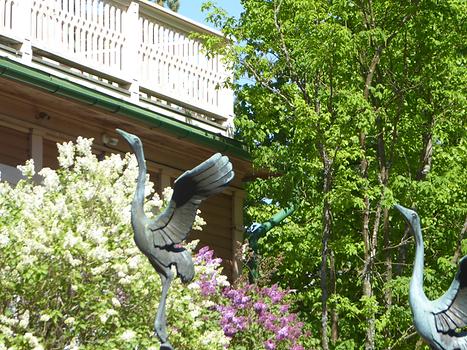
Villa on the promenade. Photo: U. & H. Maurer, June 2017

Villa on the promenade, close-up. Photo: U. & H. Maurer, June 2017
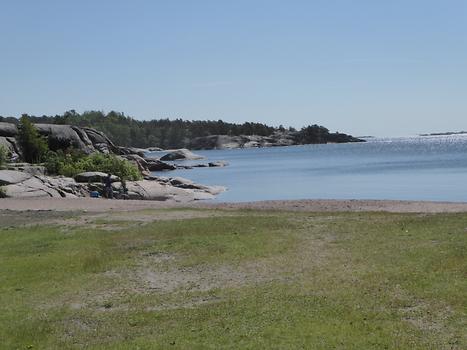
View of the seashore. Photo: U. & H. Maurer, June 2017
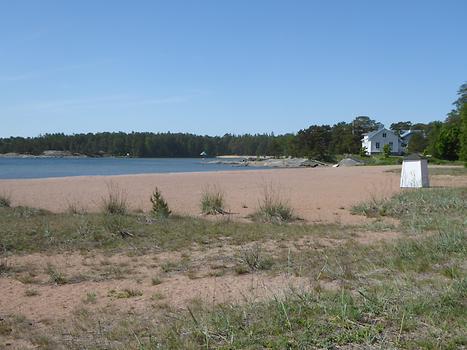
View of the seashore. Photo: U. & H. Maurer, June 2017

View of the seashore. Photo: U. & H. Maurer, June 2017

View of the seashore. Photo: U. & H. Maurer, June 2017
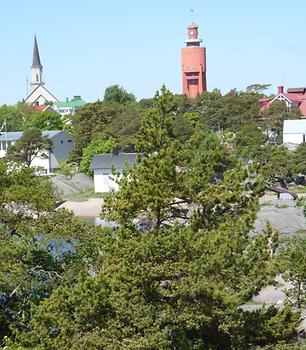
View of Hanko with church and watertower. Photo: U. & H. Maurer, June 2017

The watertower as one of the major landmarks of Hanko. Photo: U. & H. Maurer, June 2017

Hanko has a large marina. Photo: U. & H. Maurer, June 2017

Another part of the marina. Hanko also has a large commercial harbor, connected to Helsinki by a railrood line and used for exporting, since its location allows ice-breakers even in winter to provide passage, e.g. for the butter shippings Hanko was famous for a long time. Photo: U. & H. Maurer, June 2017

Quiet spot on the marina. Photo: U. & H. Maurer, June 2017










































































